|
 Secure Site
Secure Site
|
 |
 how to have get more energy When it comes to cultivating energy, you probably never did it better than when you were a toddler. You’d come barreling out of bed in the morning, eyes wide and arms full of toys. These days, you’re lucky if you can rouse yourself with multiple alarm clocks and a few cups of coffee. Snacks, if you have time to eat them, aren’t the healthy kind. As for naps and early bedtimes, they happen on rare, unplanned occasions, usually when you’re down with a cold or flu, or exhausted from running yourself ragged all week. With habits like these, it’s no wonder that more than one-third of Americans say they’re so tired that it interferes with work.
Depleted energy interferes with our lives. Feeling energetic “means having the vitality to do the things you want to do,” says Mark Hyman, M.D., editor-in-chief of the journal Alternative Therapies in Health and Medicine and author of “UltraMetabolism.” That vitality isn’t just a state of mind — it’s a physical condition. Each of our cells contains hundreds of mitochondria, tiny “power plants” that combine the oxygen we breathe with the food we eat and then burn the combination to create energy.
 increase vitality with a mindfulness practice We know this process as metabolism. How energetic we feel largely depends on how well our mitochondria are functioning. To function optimally, they need quality fuel: a wholesome, varied diet, restorative sleep, and plenty of oxygen from regular exercise. But rather than enhance our vitality, we often sabotage it with “counterfeit energy” — stimulants like caffeine that we think give us more pep but only drain our energy in the long run.
Getting your energy back is possible. Start by simply looking at your day. From morning until night, energy leaks abound. These daily habits may seem perfectly innocent, but over time they impair your body’s vitality.
Waking up in the morning should be as pleasant as falling asleep at night. The Zen Alarm Clock’s gradual, gentle awakening is transformative.
The Walnut Digital Zen Clock’s long-resonating Tibetan bell-like chime makes waking up a beautiful experience – its progressive chimes begin your day with grace. When the clock’s alarm is triggered, the acoustic chime bar is struck just once … 3-1/2 minutes later it strikes again … chime strikes become more frequent over 10 minutes … eventually striking every 5 seconds until shut off. As they become more frequent, the gentle chimes will always wake you up – your body really doesn’t need to be awakened harshly, with a Zen Clock you’re awakened more gradually and thus more naturally. Unlike artificial recorded sounds coming out of a tiny speaker in a plastic box, natural acoustic sounds transform your bedroom or office environment.
adapted from Body + Soul, September 2006
 gentle wake up clock with chime
Now & Zen’s Chime Alarm Clock Store
1638 Pearl Street
Boulder, CO 80302
(800) 779-6383
Posted in intention, Meditation Timers, Meditation Tools, mindfulness practice, sleep, Sleep Habits, wake up alarm clock, Well-being
 can yoga help you fall asleep? If you’re one of the millions of sleep-starved Americans with a dwindling supply of fence-jumping sheep, try introducing a few Downward Dogs to your bedtime menagerie. A recent clinical study at Boston’s Brigham and Women’s Hospital confirmed that bedtime yoga can help chronic insomniacs significantly reduce their tossing-and-turning time.
The results are most likely linked to yoga’s soothing effect on the central nervous system, says lead study author Sat Bir Khalsa, Ph.D., assistant professor at Harvard Medical School. In insomniacs, levels of the stress hormone cortisol are elevated,” he explains. Yoga can reduce cortisol levels, which is why you have that feeling of calm after practicing it.” And while the study’s poses were selected for their sleep-promoting effects (see below for instructions), Khalsa says most types of yoga, practiced regularly at any time of day, should bring on more nighttime ZZZs. Sleep-promoting yogic breathing exercises
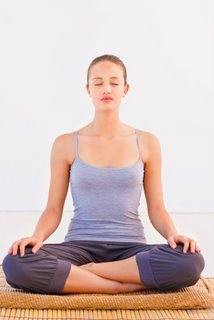 yoga exercises for insomnia Exercise 1
Sit with a straight spine, with your head erect and chin lightly tucked in. Extend both arms up to form a 60-degree angle (almost vertical), with wrists straight and palms and fingers extended flat and facing up. Keep elbows straight. Begin slow deep breathing through the nose. As you inhale, let your abdomen extend out as though it were being filled with air. As the inhale continues, let your chest expand. At the end of the inhale, pause briefly with your breath suspended; do not to lock your throat to hold the breath, but rather suspend the breath by lifting and suspending the motion of the chest. As you start to exhale, let the chest contract first. As the exhale continues, pull in your abdomen slightly as though it were being emptied of air. Pause briefly at the end of the exhale before beginning the next inhale. The breath rate should be four breaths per minute or slower (15 seconds or longer for each complete inhale/exhale). It is important that this breath, as with all of the breathing in these exercises, is done through the nose. Keep your eyes closed during this exercise, and focus your mental attention on the flow of the breath. Continue for 2 to 3 minutes using your zen timer in repeat mode. At the end, inhale deeply and hold for 10 seconds. Exhale, and let your breath relax as you keep your mental focus on the flow of the breath for about 1 minute with eyes closed.
 Yoga Timer & Chime Alarm Clock by Now & Zen, Inc. - Boulder, CO Exercise 2
Sit with a straight spine, with your head erect and chin lightly tucked in. Extend the arms out to the sides parallel to the ground. Bend the wrists with the fingers pointing straight up. (Your hands look like you’re pressing out toward two walls.) Begin slow deep breathing as described in Exercise 1. Continue for 2 to 3 minutes. At the end, inhale deeply and hold for 10 seconds. Exhale, and let your breath relax as you keep your mental focus on the flow of the breath for about 1 minute with eyes closed.
The Digital Zen Clock serves as a countdown and interval timer for yoga, meditation, bodywork, etc.; and it can also be set to chime on the hour as a tool for “mindfulness.”
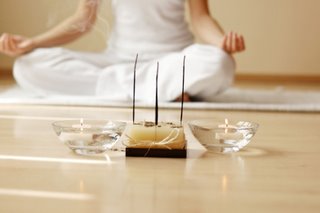 yoga for better sleep Exercise 3
Sit with a straight spine, with the head erect and the chin lightly tucked in. Press the palms together in front of the chest. The fingers of the right hand fingers go over the side of the left index finger and onto the back of the left hand. It is a “cross-lock” with the fingers crossing each other at 90 degrees. Squeeze the hands toward each other with continuous pressure. Begin slow deep breathing as described in Exercise 1. Continue for 2-3 minutes. At the end, inhale deeply and hold with a final push together of the hands for 10 seconds. Exhale, and let your breath relax as you keep your mental focus on the flow of the breath for about 1 minute with eyes closed.
Exercise 4
Sit with a straight spine, with your head erect and chin lightly tucked in. Place your hands in your lap, palms facing up, right hand over the left. The thumb tips touch and point forward. Keep the eyelids half closed. Look downward past the tip of your nose. Inhale in four equal segments through the nose. Mentally recite the sound scale, “Sah Tah Nah Mah”, with one syllable for each stroke of the breath. Then hold the breath by lifting and suspending the motion of the chest. As you hold the breath, mentally repeat the scale four times, for a total of 16 beats. Then exhale in two equal and powerful strokes out the nose. Mentally recite “Wah-Hay” on the first segment out, and “Goo-Roo” on the second stroke out. Continue for 5 to 31 minutes. At the end, inhale deeply and hold for 10 seconds. Exhale, and let your breath relax as you keep your mental focus on the flow of the breath for a few minutes. If you wake up in the night and have trouble falling back asleep, do this exercise for 5 to 11 minutes.
adapted from Body + Soul, April/May 2007
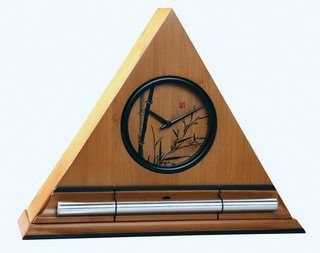 Bamboo Zen Clocks, progressive chime clock and timer for yoga Now & Zen’s Yoga Time & Chime Alarm Clock Shop
1638 Pearl Street
Boulder, CO 80302
(800) 779-6383
Posted in Insomnia, intention, Meditation Timers, mindfulness practice, sleep, Sleep Habits, Well-being, yoga, Yoga Timer, Yoga Timers by Now & Zen
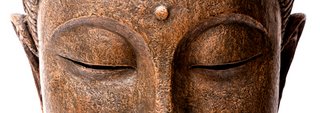 Unwind Do you need to relax? Try these three simple ways to unwind.
Take 10
Spending a few minutes alone each day allows you to assess how tired and stressed you are — information you can then use to plan the rest of the day. “We need little bits of privacy to be able to connect to our inner selves,” says Powers. Set you Chime Timer & Clock by going to the Countdown timer and programming it for 10 minutes. The Digital Zen Chime Timer & Clock’s long-resonating Tibetan bell-like chime makes ending your meditation a beautiful experience – its progressive chimes relax and rejuvenate you.
Find Nature
Take a walk in the park, or even tend to your houseplants. As Powers explains, “Spending time with the natural world nourishes your entire body.”
Be Kind
When you do experience emotional upsets, be gentle with yourself. Show compassion by giving yourself room to breathe, perhaps repeating a calming affirmation.
adapted from Body + Soul, November/December 2007
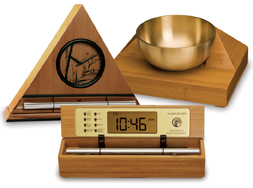 Chime Timers & Alarm Clocks by Now & Zen - Boulder, CO 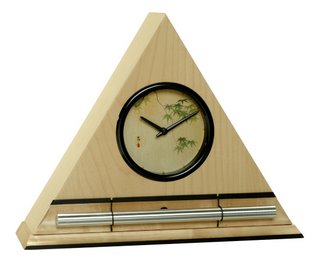 Zen Alarm Clock for Unwinding Now & Zen’s Chime Timer & Clock Shop
1638 Pearl Street
Boulder, CO 80302
(800) 779-6383
Posted in intention
 The Dream-Health Connection Physicians in early Egypt and ancient Greece encouraged people to recall their dreams when seeking medical advice. Mexican and Native American shamans have long considered dream interpretation important for both healing and spiritual awareness. Tibetan medicine views dream work as a path to self-discovery, an awareness that can help create an inner balance — and inner balance contributes to good health.
The Dream-Health Connection
Indeed, the study of dreams in relation to health is gaining acceptance in the scientific community. One study reveals that the role of REM sleep and noting dream variables may be significant in helping patients gain quicker remission from marital separation-related depression (Psychiatry Research, 1998, vol. 80). Other research finds that dream content reflects waking life stressors in people with insomnia. Several studies tracked cancer patients’ dream series and reported that their dreams may have pointed to early cues for the presence of the disease process.
Katherine O’Connell, Ph.D., a clinical psychologist, dream analyst and founder of the Dream Institute in Santa Cruz, Calif., says that “listening to dreams can save your life.” She notes that dreams not only reveal symbols for health issues that need to be resolved, but they often reveal the herbal remedy for the problem — a method of medical dream work that dates back to ancient Egypt and Greece. For example, O’Connell finds that her clients often dream of flowers or herbs that are traditionally used to treat the ailments their physicians diagnose.
In her dream-work journey, O’Connell has studied dream medicine with Tibetan lamas and researched 3,500-year-old Egyptian homeopathic remedies used for dream recall. Through the process, she has also collected more than 5,000 dreams — her own and those of clients — for analysis.
O’Connell believes that viewing your dreams as a series is the best way to understand the complete picture of your physical and psychological health. She suggests writing your dreams down, then reviewing common threads that run through them. “I see dream work as a good mystery story with many chapters,” she says. “With each chapter, we gain more clues along the way.”
Cultivating Dream Awareness
To access the clues in your dreams, start with your knowledge of yourself. While dream symbol books can serve as loose guides, dream interpretation is really an individual matter. For example, the color green may represent money to your spouse but symbolize healing energy to you. Likewise, a spider can be your personal symbol of creativity whereas it may signal a venomous threat to someone else; similar dream images often have different interpretations for different people. So it’s important to tap into your own associations, feelings and intuition about your dream symbols. “We have such innate wisdom. We must remember to trust ourselves,” O’Connell says.
Want to be more in touch with your dreams? ASD offers the following tips:
- Remind yourself to remember your dreams before you fall asleep.
- Keep a pad of paper and pen or tape recorder by your bedside. As you awaken to your chiming Zen Alarm Clock , try to move as little as possible and try not to think right away about your upcoming day. Instead, immediately write down your dreams and dream images, as they can fade quickly if not recorded.
- Influence your dreams by giving yourself pre-sleep suggestions. Before going to bed, write down your agenda. Or say aloud what you want to know to strengthen the conscious-subconscious dream connection.
- Forgo taking alcohol or stimulants such as coffee or caffeinated tea before bed, as these substances interfere with REM sleep. Also, try taking a warm bath with a few drops of chamomile or cedar essential oil (first diluted in a carrier oil such as almond or walnut), or try practicing a few minutes of meditation to clear your mind for restful sleep and clearer dreams. Dreams not only have the potential to enhance your health but, as Jungian analyst Marie-Louise von Franz says, “Dreams show us how to find meaning in our lives, how to fulfill our own destiny and how to realize the greater potential of life within us.”
Sweet dreams.
adapted from Delicious Living, October 2000 by Deborahann Smith
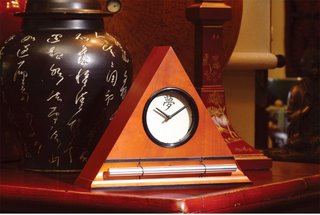 Zen Alarm Clocks with a progressive chime that doesn't interrupt your dreams Now & Zen – The Zen Alarm Clock Shop
1638 Pearl Street
Boulder, CO 80302
(800) 779-6383
Posted in Dreams, Japanese Inspired Zen Clocks, Natural Awakening, sleep, Sleep Habits, Zen Alarm Clock
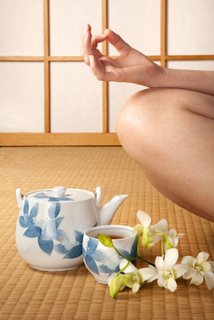 enjoy a meditative cup of tea A meditative act
Many tea drinkers say that drinking tea is not the sole purpose for the ceremony. At the Rocky Mountain Tea Festival, an annual summer event hosted by the Dushanbe Teahouse in Boulder, Colorado, tea professionals from around the country impart information on ceremonies and tea varieties. At the heart of every presentation is the message that the spirit of tea (chado) is intricately linked with simplicity and calmness.
Fellman, a busy woman who values the sense of well-being she derives from tea, strikes a happy medium between a to-go mentality and a traditional tea ceremony by preparing two spots in her home with an electric kettle, canisters of loose tea, and a cup or teapot. Selecting her spots carefully to provide “something nice to rest my eyes on that feels nourishing to me,” Fellman can enjoy a good cup of tea in twenty minutes. When brewing tea, Fellman listens to the water bubble and watches for steam. She looks carefully at the amount of tea used, breathes in the gentle fragrance of the leaves, and waits for the warmth of the teacup to pull the tension from her shoulders. “The mindful process of making a good cup of tea,” she says, “helps me take time to stop and focus.”
It’s no coincidence that elements of tea preparation are reminiscent of meditation. Buddhist monks served tea in places where a rogi, or path, had to be crossed in order to reach the tearoom and, in essence, leave the cares of the world behind. Today, tea drinkers focus on the art of brewing tea to separate themselves from daily concerns.
 time for a meditative cup of tea Tea professionals suggest taking classes to learn the basic elements and history of the tea ceremony. “You can’t read a book and understand it,” says Austin Babcock, a member of the Washington, D.C., branch of the Urasenke Foundation, who likens tea ceremony education to mastering a martial art or learning to play an instrument. “It’s about getting it with your body. It’s an experience.” The Urasenke Foundation, a school of tea that offers classes worldwide, was founded by sixteenth-century tea master Sen no Rikyu, who is credited with establishing tea as a social and spiritual practice.
“There is a Zen quality” to tea ceremony, says Babcock. It creates “a calming, meditative space that allows you to open up your heart to another person. It is a powerful act of sharing . . . and of savoring the moment.”
adapted from Natural Home Magazine, September/October 2002 by Heather Grimshaw
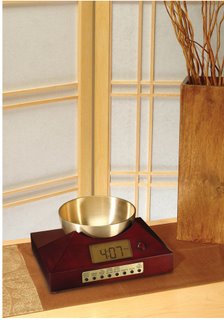 a Tibetan bowl/gong timer for timing tea Now & Zen’s Mindfulness Clock & Timer Store
1638 Pearl Street
Boulder, CO 80302
(800) 779-6383
Posted in intention, Meditation Timers, Meditation Tools, mindfulness practice, Zen Timepiece by Now & Zen, Zen Timers
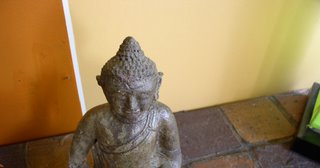 How to meditate Some traditions believe that, to truly practice meditation, you must turn your back on the world: Monks in Thailand live in the woods, hundreds of miles from civilization. Other traditions emphatically state that you must engage in the whole of life, as Buddhist meditation teacher Jack Kornfield attests: “We may start by practicing meditation much like practicing piano. Eventually, when we become proficient, we will not need to practice anymore. Just as playing becomes practice, everything we do will become meditation. In the end, meditation techniques transcend even themselves. Then, there will be neither meditation or non-meditation. Just what is.”
Those disinclined to move into the deep woods, or not far enough along the woodsy path to make every moment a meditation, can create a proscribed area for meditation. While doing this, pay attention to Zen Master Shunryu Suzuki’s advice in his classic treatise, Zen Mind, Beginner’s Mind (Weatherill, 1990): Try to see the space without preconceptions or expectations. As Suzuki puts it,”In the beginner’s mind, there are many possibilities; in the expert’s mind, there are few.” Keep it simple, and make it real.
Our Zen Timepiece’s acoustic 6-inch brass bowl-gong clock is the world’s ultimate alarm clock, practice timer, and “mindfulness bell.”
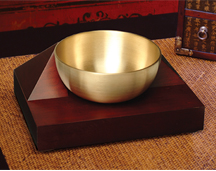 Meditation Timers and Alarm Clocks for a Peaceful End to Your Mindfulness Practice It fills your environment with beautifully complex tones whenever it strikes. It’s exquisite sounds summon your consciousness into awakening with a series of subtle gongs that provide an elegant beginning to your day. Once you experience the Zen Timepiece’s progressive awakening, you’ll never want to wake up any other way.
Our Singing Bowl Meditation Timer also serves as a countdown and interval timer for yoga, meditation, bodywork, etc.; and it can also be set to chime on the hour as a tool for “mindfulness.”
adapted from Natural Home Magazine, November/December 2000 by Kelly Smith
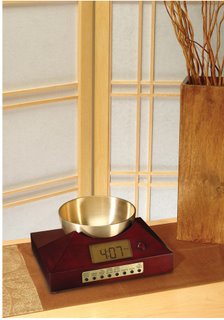 Singing Bowl Meditation Timer from Now & Zen, Inc. - Boulder, CO Now & Zen’s Meditation Timer & Alarm Clock Store
1638 Pearl Street
Boulder, CO 80302
(800) 779-6383
Posted in intention, Meditation Timers, Meditation Tools, mindfulness practice, Zen Timers
 Awareness As a sustainable communities professor at Dominican University of California, I love to give my students strange assignments and then watch them grow. In turn, they’ve taught me much about coming into the right relationship with life.
Modern living involves high levels of sensory input—much of it meaningless or even nasty. So we shut down. Our magnificent equipment—which allowed our ancestors to feel a shift in the breeze, smell ripening fruit, hear every footfall and see subtle color changes—goes into standby mode. But we need our senses to tell us what we crave (birdsong, sunshine, a gurgling stream, ripe fruit) and what we reject (leaf blowers, smog, clutter). Our senses bring us to life.
So at the beginning of class, I ask students to pause. “Close your eyes, take a deep breath and relax. What do you smell? What do you hear—near, far, steady, intermittent? How does the air feel on your skin—dry, moist, moving, still, cold, warm? Now slowly open your eyes, and notice shapes, colors, light, dark, near, far. What appeals to your senses, and what is a turnoff? What are you aware of now that you weren’t before?”
Suddenly, the students are aware of both the unpleasant and the delicious. They dislike the sounds of traffic, ticking clocks, and mechanical heating and cooling systems. And if there is even one green growing thing, one ray of sunshine or one bird singing, they fall in love with it. In fact, if the weather is decent, they ask, “Can we have class outside?”
Where are you?
At the end of class, I send students home with an expanded assignment: At least once a day, stop and notice how the air feels, where the sun is, the wind’s direction, the terrain, vegetation, critters; then write it all down. This exercise has changed a few lives.
Matt, an urban apartment dweller, realized that he’d been tolerating noise levels that caused tension by day and insomnia by night; he moved, and now he feels like a different person.
Cheryl lives in a suburb and takes the bus to work. She recently began walking to a neighborhood bus stop rather than driving to a central stop, partly so she could spend more time outdoors. She became more aware of trees, birds and weather conditions and more familiar with her neighbors. She noticed that birds were more active and vocal when the sky was clear; she noticed when the geese started flying south and missed them when they were gone. Observing the trees, she noticed the wind’s direction. “The peaceful window of time to myself first thing in the morning helps me start my day with more clarity and calmness,” she says. “And walking home at night, I enjoy gazing at the beautiful night sky and the changing moon.”
Josh lives near the ocean. Sensory tune-ins made him more aware of the breeze, and he wanted to play with it. He put up a wind sock and soon noticed that the wind usually came from the northwest. But why? He explored regional wind patterns, and I encouraged him to study storm fronts and cyclonic wind patterns. Then he bought a little weather station to keep track of wind, air temperature and barometric pressure. After I suggested that he also note his physical and emotional feelings, he had an epiphany: His moods were often directly related to weather conditions.
Cheryl and Josh are beginning to grasp that nature is everywhere and that everything affects everything else. This also has a practical application: They are gaining observation skills that will make them good ecological designers, able to create habitations that are powered by natural elements and friendly to the biosphere.
 balancing rocks In a culture that treats our bodies as isolated machines, it’s world-changing to notice our craving for harmony with other natural phenomena—and starting to learn how to satisfy it. Getting outdoors, listening to our bodies, watching birds, tracking breezes and cycling with the sun are enjoyable in themselves, but they lead us to something much larger: an understanding of how the world works. And once we get it, there’s no going back. The insights keep multiplying, and we’re motivated to greater and deeper actions by feeling truly, deeply alive.
As my student Brian says, “When I stop everything and sit as part of it all, I feel the connection rather than intellectualizing interconnectedness.” Because everything is interconnected, we can start our journey anywhere, with deceptively simple steps: stop, look, listen, feel.
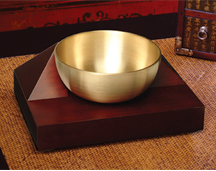 Singing Bowl Meditation Timer from Now & Zen, Inc. - Boulder, CO The Zen Timepiece (with Tibetan- Singing Bowl) serves as a countdown and interval timer for yoga, meditation, bodywork, etc.; and it can also be set to chime on the hour as a tool for “mindfulness.”
adapted from Natural Home Magazine, September/November 2009 by CarolVenolia
Carol Venolia is an eco-architect and co-author of Natural Remodeling for the Not-So-Green House (Lark Books, 2006). She teaches in the Sustainable Communities program at Dominican University of California.
 Chime Meditation Timers and Clocks with Chime in Bamboo, Walnut, Maple, and Black Lacquer Now & Zen’s Meditation Timer & Alarm Clock Shop
1638 Pearl Street
Boulder, CO 80302
(800) 779-6383
Posted in Insomnia, mindfulness practice, Natural Awakening, nature, Well-being
 Meditation You know it when stress takes hold: Your heart starts racing. Your jaw clenches. It’s nearly impossible to concentrate.
And over the long run, stress can contribute to serious health problems, including high blood pressure, heart attacks, ulcers and lower back pain.
“The problem most often comes up when the demands of the job outweigh the employee’s ability to control his or her environment,” explained Fred Blosser, a spokesman for the National Institute for Occupational Health and Safety, the federal agency that researches how to prevent work-related injury and illness.
Blosser said that today there is more awareness among employers that stress can influence workers’ well-being, health and productivity. NIOSH and the American Psychological Association advise companies to lead the charge in reducing job stress by overhauling an organization’s structure and its expectations of employees.
Those recommendations include ensuring that workloads are in line with workers’ capabilities and resources; defining workers’ roles and responsibilities; and establishing work schedules that are compatible with demands and responsibilities outside the job.
But Dr. Redford Williams, who teaches psychiatry and behavioral sciences at Duke University, said too few businesses offer effective stress-management programs for employees. He said it is up to individuals to learn how to handle a difficult environment by honestly assessing the triggers that make their blood boil.
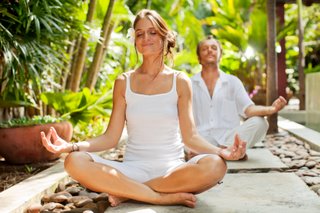 Meditation “You cannot run from stress,” said Williams. “You cannot hide. You need evaluation tools so you can make a rational decision about chilling out or coming out swinging to change the situation.”
Are You Worth It?
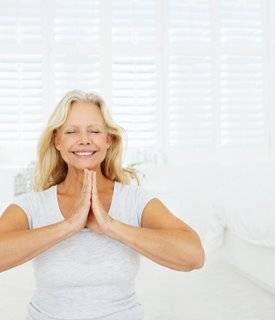 Reduce Stress In his new book, “In Control,” published by Rodale next month, Williams offers tips for people eager to alter their feelings of frustration on the job. He advises that you take stock of the problem that is causing you angst, and recommends his “I Am Worth It” method.
“I” stands for “Is what’s stressing me out important? Or is it simply a minor annoyance?” “A” stands for “Is my response to the stressor appropriate? Am I responding the way any other person would or am I overreacting?” “M” stands for “Is the situation modifiable? Can it be changed?”
And “Worth It” asks a person to examine what’s at stake in taking some action. For example, will it help or hurt you to go over your new manager’s head to discuss your overwhelming workload, or would it be more prudent to wait until your new boss has settled into the job?
Williams believes it is critical to distinguish whether situations that set you off stem from something valid and whether they’re possible to fix. If the problem is minor (a cubicle neighbor who talks too loudly on the phone) or out of your control (increasing health care costs or the threat of lay-offs), Williams said a brief timeout for meditation can help.
“Take a one minute relaxation break,” he said. “Sit in a chair, both feet on the ground. Take in a slow, deep breath and say to yourself ‘Relax’ when you exhale.”
Finally, experts agree that exercise — as well as a healthy diet — can also play a valuable role in reducing stress in and out of the workplace.
Physical activity, including walking, swimming, running and even gardening for at least 30 minutes, three times a week can elevate your mood and help you cope.
Although meditation can be done in almost any context, practitioners usually employ a quiet, tranquil space, a meditation cushion or bench, and some kind of timing device to time the meditation session. Ideally, the more these accoutrements can be integrated the better. Thus, it is conducive to a satisfying meditation practice to have a timer or clock that is tranquil and beautiful. Using a kitchen timer or beeper watch is less than ideal. And it was with these considerations in mind that we designed our digital Zen Alarm Clock and practice timer. This unique “Zen Clock” features a long-resonating acoustic chime that brings the meditation session to a gradual close, preserving the environment of stillness while also acting as an effective time signal. The Digital Zen Clock can be programmed to chime at the end of the meditation session or periodically throughout the session as a kind of sonic yantra. The beauty and functionality of the Zen Clock/Timer makes it a meditation tool that can actually help you “make time” for meditation in your life.
adapted from abcnews.go.com by Heather Cabot
Now & Zen – The Digital Meditation Timer Shop
1638 Pearl Street
Boulder, CO 80302
(800) 779-6383
orders@now-zen.com
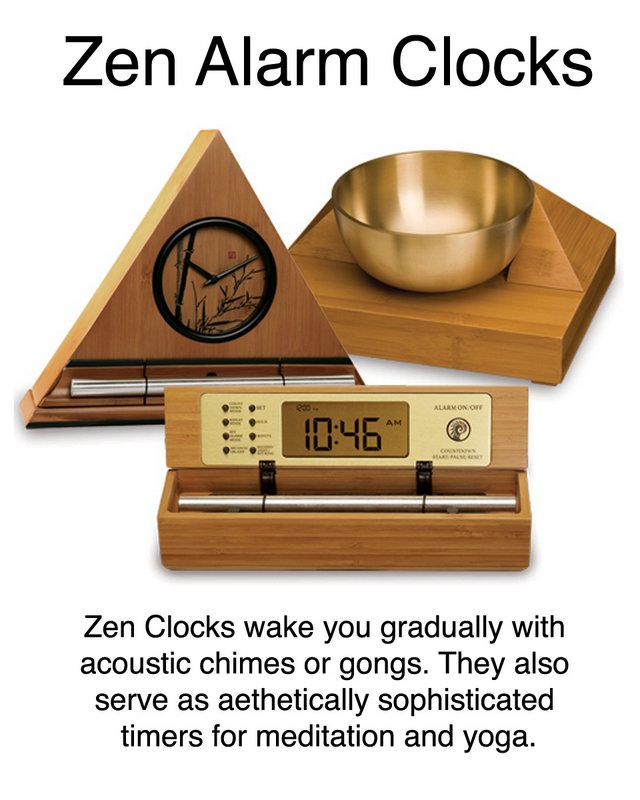 Meditation timers and acoustic clocks
Posted in Bamboo Chime Clocks
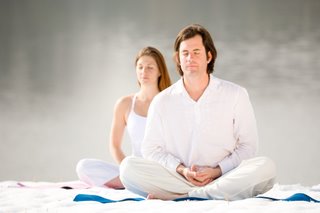 Meditation Can Wish You Well New research suggests that qualities the world desperately needs more of — love, kindness and compassion — are indeed teachable.
Imaging technology shows that people who practice meditation that focuses on kindness and compassion actually undergo changes in areas of the brain that make them more in tune to what others are feeling.
“Potentially one can train oneself to behave in a way which is more benevolent and altruistic,” said study co-author Antoine Lutz, an associate scientist at the University of Wisconsin-Madison.
How far this idea can be extrapolated remains in question, though.
“I think there’s no question that people can benefit from these practices,” said Dr. Louis Teichholz, medical director of complementary medicine and chief of cardiology at Hackensack University Medical Center in New Jersey. “I think the question is how easy is it to get trained enough so that it will make a clinical difference, and I don’t think this study answers that.”
The findings were published in the March 26 issue of the Public Library of Science One.
Recent brain-imaging studies have suggested that the insula and the anterior cingulate cortices regions are involved in the empathic response to other people’s pain. But not much is known about how cultivating compassion might affect brain circuitry.
And previous research has indicated that meditation may reduce the brain’s reaction to pain, and that it may actually improve cardiovascular health by decreasing the risk of metabolic syndrome.
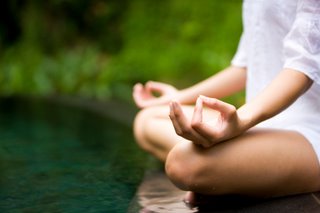 Meditation Pose “The main research question was to see whether some positive qualities such as loving-kindness and compassion or, in general, pro-social altruistic behavior, can be understood as skills and can be trained,” Lutz explained.
In the same way that training in sports or chess or music produces functional and structural changes in the brain, the Wisconsin researchers wanted to see if cultivating compassion through the practice of meditation also produced brain changes — suggesting that compassion could be viewed as a learned skill.
The study involved 32 people: 16 Tibetan monks and lay practitioners, who had meditated for a minimum of 10,000 hours throughout their lifetime (the “experts”); and 16 control subjects, who had only recently been taught the basics of compassion meditation (the “novices”).
The senior author of the paper, Richard Davidson, a professor of psychiatry and psychology at the University of Wisconsin-Madison and an expert on imaging the effects of meditation, has been collaborating with the Dalai Lama since 1992, studying the brains of Tibetan monks.
For the study, individuals in the control group were instructed first to wish loved ones well-being and freedom from pain, then to wish such benefits to humankind as a whole.
“We looked at whether there were any differences between experts and novices in generating compassion with the idea that a central practice in this tradition [of meditation] is to cultivate these positive emotions,” Lutz said. “We wanted to see if there were any differences in the way the brain was reacting.”
Each participant was hooked up to a functional MRI both while meditating and not meditating. During each state, the participants heard sounds designed to produce responses: the negative sound of a distressed woman, the positive sound of a baby laughing, and the neutral sound of background noise from a restaurant.
“We showed altered activation in brain circuitry that was previously linked to empathy and perspective-taking or the capacity to understand other’s intentions and mental states and, more precisely, the insula was more activated, particularly in response to negative emotional sounds,” Lutz said.
In the monks, especially, these areas of the brain were activated even more when they hard the cries of the distressed woman, she said.
 Meditation The study authors hope the findings might one day help with a range of problems, including reducing the incidence of bullying in schools or helping people with depression.
“The next step is to see if this works,” Lutz said. “If it works, then it can be applied to selective populations — for instance, depressed people or, more broadly, in education.”
More information
The U.S. National Center for Complementary and Alternative Medicinehas more about meditation and health.
Use our unique “Zen Clock” which functions as a Yoga Timer. It features a long-resonating acoustic chime that brings your meditation or yoga session to a gradual close, preserving the environment of stillness while also acting as an effective time signal. Our Yoga Timer & Clock can be programmed to chime at the end of the meditation or yoga session or periodically throughout the session as a kind of sonic yantra. The beauty and functionality of the Zen Clock/Timer makes it a meditation tool that can actually help you “make time” for meditation in your life. Bring yourself back to balance.
adapted from abcnew.go.com by Amanda Gardner
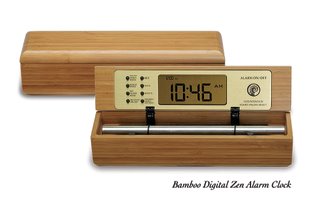 Digital Meditation Timer with Acoustic Chime Now & Zen – The Meditation Timer Shop
1638 Pearl Street
Boulder, CO 80302
(800) 779-6383
orders@now-zen.com
Posted in Bamboo Chime Clocks
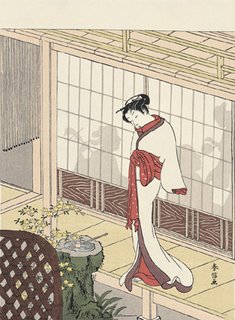 Getting More Sleep Can Improve Your Health - Harunobu Suzuki, Beauty at the Veranda President Bill Clinton’s stamina kept him so keyed up as he travelled around the world recently that it seemed hard to keep up with him, or figure out where we would see him next.
Clinton seemed to blame his recent heart troubles — he was fitted with stents to reopen a clogged artery –on a lack of sleep.
“I tell you what. I was quite tired over Christmas and afterward,” the former president said at a recent press conference. “But from the time of the Haiti earthquake which was a month ago today, I’ve been working a lot without sleeping much.”
And Clinton’s not the only one. Lack of sleep is the most common sleep complaint among Americans, according to the National Sleep Foundation.
Researchers say lack of sleep is connected to cardiovascular disease, hypertension and high blood pressure. It also compromises the immune system, contributes to obesity and severely impairs mental judgment.Dieting might be more difficult too. Recent findings also show that when you are sleep deprived, your body actually boosts production of the hormone that makes you hungry.
But research suggests that getting just one extra hour of sleep each night could dramatically affect your health. In fact, researchers from the University of Chicago found that those who bumped up their hours of sleep, from 6 to 7 hours had a 33 percent decreased chance of having clogged arteries.
But while the thought of sleeping in may seem enticing, for many Americans, it’s easier said than done.
 Getting More Sleep Can Improve Your Health - Harunobu Suzuki, Beauty at the Veranda Struggling to Stay Awake
Susan Roberts of Dahlonega, Ga. suffered from insomnia since childhood.
“I have been struggling with being sleepy all the time. Driving home from work I would have to stop and get a soda and a candy bar just to keep me awake,” Roberts said. “When I do fall asleep I end up waking up every two hours.”
She wakes up at 3:30 a.m. each morning and drives 53 miles one way to work — a routine she says she finds exhausting. Yet, she’s unable to rest. After many waking nights, Roberts said she felt her health and emotional well-being was at risk. Roberts eventually checked herself into the Northside Hospital Sleep Disorder Center in Atlanta.
How to Get that Extra Hour
Amid the hustle of every day stress, there are some simple steps people can take to get a better night’s sleep.
“You need to set aside the time for sleep. You need a few hours to unwind before. It takes time for the brain to wind down,” said Dr. Charles Czeisler, professor of sleep medicine at Harvard Medical School.
At Northside Hospital Sleep Disorders Center Roberts was taught “sleep hygiene,” — a healthy routine that should be practiced before bed.
Stimulants — soda, chocolate, any kind of caffeine — should be avoided at least four hours before bed, she said. She also said that you should not exercise three to four hours prior to sleep. Eating a light meal and eliminating alcohol consumption also helps. And lights should be dimmed and the TV turned off to help prepare the mind to relax into a slumber.
Roberts even quit cleaning her house at night. “I was having a problem going to sleep,” she said. “And doing heavy housework, I might as well have gone to the gym and worked out.”
And calling it an earlier night may show some benefits. In a 2009 study published in the New England Journal of Medicine, heart attacks in Sweden rose by 5 percent in that first week of spring, when many people were adjusting to losing an hour of sleep. In the fall when the clocks are reset, heart attacks dropped, according to the study.
 Getting More Sleep Can Improve Your Health “Most of these findings are so recent that the average physician is unaware of the link between chronic sleep deprivation and cardiovascular disease,” said Czeisler.
After learning more about her own pre-bed habits and changing some behaviors, Roberts is now on the right track with her sleep. She’s in bed by 9:30 p.m.and clocks in at least six hours of sleep– not ideal, but a major improvement for Roberts. Many know that it is not easy to get that extra hour, but as Roberts learned, never has it been so clear that its worth trying.
“I feel more alive, I have more energy, I can get my job done,” she said. “I’m not sitting at my desk falling asleep.” For more information on healthy sleep habits visit UnderstandingSleep.org
Boulder, Colorado—an innovative company has taken one of life’s most unpleasant experiences (being startled awake by your alarm clock early Monday morning), and transformed it into something to actually look forward to. “The Zen Alarm Clock,” uses soothing acoustic chimes that awaken users gently and gradually, making waking up a real pleasure. Rather than an artificial recorded sound played through a speaker, the Zen Clock features an alloy chime bar similar to a wind chime. When the clock’s alarm is triggered, its chime produces a long-resonating, beautiful acoustic tone reminiscent of a temple gong. Then, as the ring tone gradually fades away, the clock remains silent until it automatically strikes again three minutes later. The frequency of the chime strikes gradually increase over ten-minutes, eventually striking every five seconds, so they are guaranteed to wake up even the heaviest sleeper. This gentle, ten-minute “progressive awakening” leaves users feeling less groggy, and even helps with dream recall.
What makes this gentle awakening experience so exquisite is the sound of the natural acoustic chime, which has been tuned to produce the same tones as the tuning forks used by musical therapists. According to the product’s inventor, Steve McIntosh, “once you experience this way of being gradually awakened with beautiful acoustic tones, no other alarm clock will ever do.”
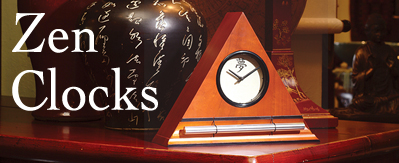 Gentle Zen Alarm Clocks with Chime Now & Zen, Inc.
1638 Pearl Street
Boulder, CO 80302
(800) 779-6383
orders@now-zen.com
Posted in Bamboo Chime Clocks
|
|
|
|